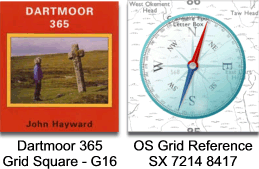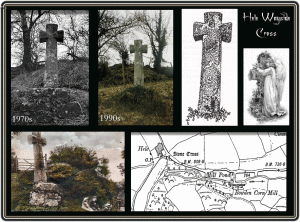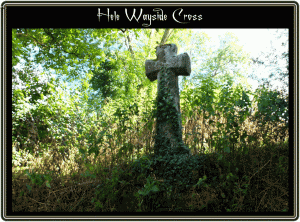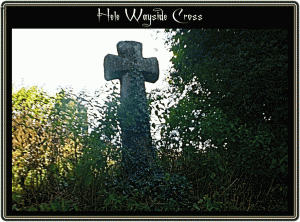
Down a small and narrow lane which leads off Beetor Cross is the small farm called Hele and it is this that lends its name to an ancient wayside cross and also a crossroads some 600 metres to the north. The place-name ‘Hele’ is a common one in Devon and on Dartmoor there are at least another three such named crossroads. The English Place-Name Society suggest that the name stems from the old Anglo Saxon word ‘healh‘, Gover et. al. p.46. Clark Hall in his ‘Concise Anglo-Saxon Dictionary’ gives several meanings of the word, these being: corner, nook, secret place and in addition a small hollow in a hill-side or slope, p.173.
So onto the actual Hele Wayside Cross, firstly why should it have been located in its present location? The whole purpose of wayside crosses was twofold, firstly to mark a well trodden path as a guidepost, it has been muted that originally the arms of the cross would align with the direction of the route. Secondly to provide reassurance to the traveller that divine protection was at hand and to present opportunities to offer up prayers for a safe passage. The route that the cross would have stood by was that which ran/runs from North Bovey to the Tavistock to Moretonhampstead road, now the B3212. However, with regards to the cross’s current location there is a slight problem, William Crossing noted: “A tradition exists in the neighbourhood that a small chapel once stood close to the stream which runs below, and that from there the cross was brought. Around it pilgrims were wont to gather ere setting out across the moor to visit the abbey of Tavistock, and to offer prayers in the little shrine.”, p.154. So there is a vague possibility that Hele Cross also signified that a wayside chapel was nearby but whether this is true or not nobody knows and according to English Heritage there is no trace of a chapel anywhere below the cross anymore if ever. Crossing also tells us that in 1870s somebody with little respect for such things began to extract gravel from underneath the cross. The result of this was a hollow which effectively undermined the cross and put it in danger of collapsing into it. In 1868 a local mason from nearby North Bovey was hired to move the cross away from the danger and with the help of a clamp fixed it upon the rock on which it sits today, the cost of the restoration was met by the Earl of Devon. p.154. Harrison notes that in 1823 a certain J. P. Jones described Hele Cross as being the “finest cross on the moor,” and locates it at “Yaal, west of North Bovey,” p.236. How on earth Mr. Jones came across that place-name is anyone’s guess.
Thanks to the Earl of Devon the cross we see today can be described as being of the Maltese Cross style with octagonal chamfered and tapered edges. The cross stands a proud 1.75 metres high, has an arm span of 63 centimetres and a shaft circumference of 94.5 centimetres. Sandles, p.44. The arms are aligned in a north – south direction which certainly would conform to the idea of arms pointing the direction of the route.

Clark Hall, J. R. 2004. A concise Anglo-Saxon Dictionary. London: Toronto University Press.
Crossing, W. 1987. The Ancient Stone Crosses of Dartmoor. Exeter: Devon Books.
Gover, J. E. B., Mawer, A. & Stenton F. M. 1992. The Place Names of Devon. Nottingham: The English Place-Name Society.
Sandles, T. 1997. A Pilgrimage to Dartmoor’s Crosses. Liverton: Forest Publishing.

 Legendary Dartmoor The many aspects past and present of Dartmoor
Legendary Dartmoor The many aspects past and present of Dartmoor




Brilliant piece of work again Tim as always
Mike